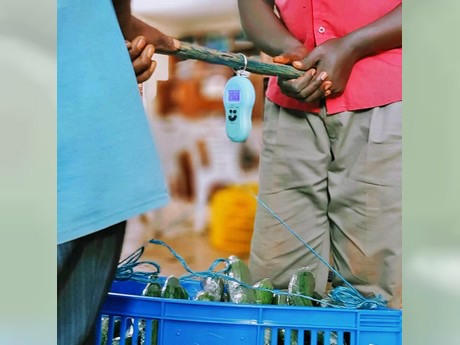It's been a year since Illuminum first launched their product greenhouse plus+ and so they thought, why not share the lessons they have learnt over the past 1 year?
Lesson 1: Less is more!
"Farmers have a lot of factors to consider when growing crops, what seeds to use? What fertilisers to apply? Do I irrigate in the morning or evening? How much water should I use? and the list goes on and on. We needed to lessen these questions so that they could grow more and increase their income. So, we decided to bring on board partners that would address each question a farmer would have across the value chain. From soil testing companies, to seed companies, to agronomists and even crop insurance companies all under 1 roof leaving our farmers to focus on purely what they love most which was crop husbandry."
Lesson 2: Weekly crop updates
"We realized that visiting a farmer once a month to train them on how to grow inside a greenhouse was a long time and any recommendations given during this time were not quick to turn around the crop. We had to increase the number of visits so that we could be able to address any pests and diseases issues in time and avoid further damage. Even though some farmers received weekly visits, we had other farmers that only needed 1 visit every 2 weeks. The success was actually more visible on the bi weekly visits and allowed us to adopt this as the standard agronomic practice for all our farmers under the greenhouse plus+ program."

Farmers weighing fresh cucumbers before collection to urban cities
Lesson 3: Economies of Scale
"Different farmers took different sizes of greenhouses from our Kadogo greenhouse 8M by 15M=120sq.m all the way to our Mzoefu Greenhouse 16M by 30M=480sq.m (almost the size of a basketball court). In all these greenhouses, they all had fixed costs while some costs were variable and depended on the size of the greenhouse. Variable costs included seeds, fertilizers, chemicals and even water for irrigation. However, the fixed costs were labour salaries, agronomic visits and produce collection costs. Farmers with smaller greenhouses were using 1 person to take care of their greenhouse while farmers with even 2 units of the Mzoefu Greenhouse-16M by 30M were using the same 1 person. Salaries were the same but given that the production area was bigger on the second case, it allowed farmers with bigger units to enjoy a bigger pie. Agronomic visits were made twice per month with each visit costing the same. Since this is taken as a consultancy, it has 1 cost not dependent on the growing area. The major disadvantage was the high capital costs of taking up the Mzoefu which costed 4 times the cost of the Kadogo. Our best performing size that was not too high for the farmer and at the same time the yield was significant to cover the expenses was the Mwanzishi Greenhouse 8M by 30M. With an average of 33% return on investment per annum."
Lesson 4: Planting Cycles
"Most of our farmers planted all their crops at the same time therefore when they went out of season, they did not have income to cushion them from monthly expenses such as salaries and utilities. For farmers that had taken more than one unit, we followed planting cycles by spacing the planting dates of each unit by up to 1 month which allowed them to have continuous harvests through out the entire year. The output of course would fluctuate but they were confident on having income spread out through out the growing cycle."
Lesson 5: Farming Records
"As much as we had agronomists visiting these farms every two weeks, we needed to know what activities took place in the farm. We were able to note that farmers that had farming records had less occurrence of pests and diseases and their yield was much more. Identifying even causes of problems was easy as we could simply refer to the records for all information concerning the amount of water irrigated, the number of seeds planted, chemicals used and fertilizers applied. Farmers with records also found expansion easier as they had a point of reference for all their farming practice information. At the time of produce collection and payment reconciliation, it was also easy for the farmers to correct deliveries that our customers had complaints with. We hope to continue this practice to allow full traceability of our farms enabling the customers to get healthy foods."
Lesson 6: Management matters
"We had farmers that succeeded and farmers that failed. When we did our root cause analysis to understand why failures occurred yet all farmers had the same agronomist, same seeds and same inputs, we realized that 87% of farmers failed because of poor crop management by the farm workers. We dug deeper and realized that the farm workers left to operate the greenhouses did not have any background or experience in agriculture. They were new to aspects of weeding, spraying and even irrigation. This made it difficult for them to implement recommendations given by the agronomists. In some cases, farm workers were spraying the wrong chemicals to the wrong plant causing more damage to the crops. For farms that had farm workers with experiences in farming, implementation of recommendations by the agronomist was excellent and this translated to greater yield.
"Over the course of the implementation of greenhouse plus+, we have been able to deliver over 438 Tonnes of fresh produce from farms across Kenya to our customers both local and abroad. This access to the market has greatly helped our farmers who now can return their investment and continue growing their production sites in order to gradually increase their turnover.
"We believe, by bringing on board all these partners needed on the value chain and connecting farmers to markets, we can increase income for farmers while ensuring we feed our growing urban population."
This product is currently available to all farmers in Kenya with plans to slowly roll out to East Africa.
For more information: Illuminium Greenhouses
Illuminium Greenhouses
info@illuminumgreenhouses.com
illuminumgreenhouses.com
